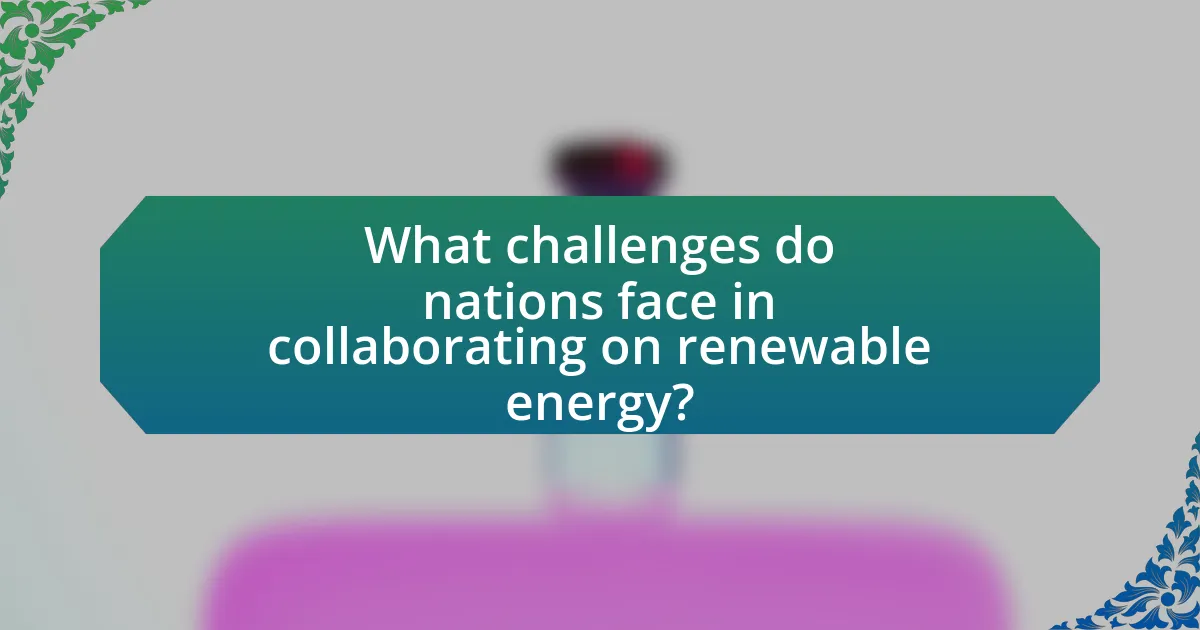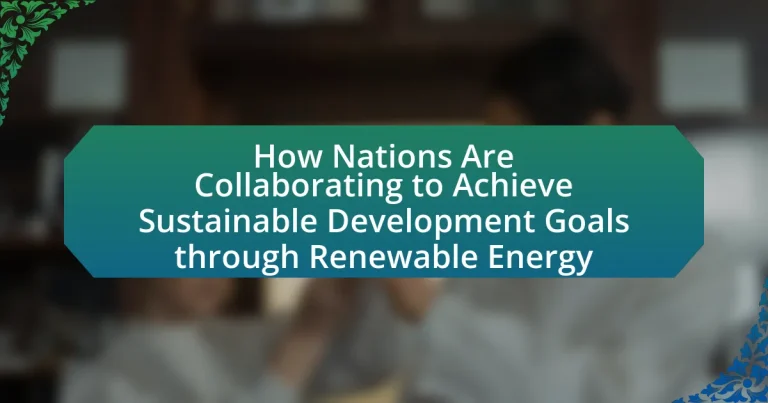The article examines how nations are collaborating to achieve the Sustainable Development Goals (SDGs) through renewable energy initiatives. It highlights the role of international partnerships, such as those facilitated by the International Renewable Energy Agency (IRENA) and the Clean Energy Ministerial, in promoting technology sharing and joint projects aimed at enhancing renewable energy deployment. The significance of the SDGs, particularly Goal 7, is discussed in relation to ensuring access to sustainable energy, while the article also addresses the economic and environmental benefits of renewable energy, the challenges faced in international cooperation, and the strategies nations can adopt to improve collaboration in this critical sector.

How are nations collaborating to achieve Sustainable Development Goals through renewable energy?
Nations are collaborating to achieve Sustainable Development Goals (SDGs) through renewable energy by forming international partnerships, sharing technology, and investing in joint projects. For instance, the International Renewable Energy Agency (IRENA) facilitates cooperation among countries to enhance renewable energy deployment, which is crucial for meeting SDG 7, aimed at ensuring access to affordable, reliable, sustainable, and modern energy for all. Additionally, initiatives like the Clean Energy Ministerial bring together governments to promote policies and share best practices that accelerate the transition to renewable energy sources, thereby supporting multiple SDGs related to climate action and sustainable economic growth.
What are the Sustainable Development Goals and their significance?
The Sustainable Development Goals (SDGs) are a set of 17 global objectives established by the United Nations in 2015 to address pressing social, economic, and environmental challenges by 2030. These goals aim to eradicate poverty, protect the planet, and ensure prosperity for all, emphasizing the interconnectedness of these issues. The significance of the SDGs lies in their universal framework that encourages countries to work collaboratively towards sustainable development, fostering partnerships and mobilizing resources to achieve measurable outcomes. For instance, Goal 7 focuses on ensuring access to affordable, reliable, sustainable, and modern energy for all, highlighting the role of renewable energy in achieving broader sustainability objectives.
Why were the Sustainable Development Goals established?
The Sustainable Development Goals (SDGs) were established to address global challenges such as poverty, inequality, climate change, environmental degradation, peace, and justice. Adopted by all United Nations Member States in 2015, the SDGs consist of 17 goals aimed at creating a better and more sustainable future for all by 2030. The establishment of these goals was driven by the need for a unified framework to guide international efforts in achieving sustainable development, as evidenced by the recognition of the interconnectedness of social, economic, and environmental dimensions in the 2030 Agenda for Sustainable Development.
How do the Sustainable Development Goals relate to renewable energy?
The Sustainable Development Goals (SDGs) directly relate to renewable energy by emphasizing the importance of affordable, reliable, sustainable, and modern energy for all, specifically outlined in Goal 7. This goal aims to ensure universal access to electricity and promote the use of renewable energy sources, which are essential for reducing greenhouse gas emissions and combating climate change. According to the International Renewable Energy Agency, transitioning to renewable energy could help achieve up to 70% of the emissions reductions needed to meet global climate targets. Thus, the SDGs and renewable energy are interconnected in promoting sustainable development and environmental sustainability.
What role does renewable energy play in sustainable development?
Renewable energy is crucial for sustainable development as it provides a clean, sustainable source of power that reduces greenhouse gas emissions and reliance on fossil fuels. By transitioning to renewable energy sources such as solar, wind, and hydroelectric power, nations can meet energy demands while minimizing environmental impact. According to the International Renewable Energy Agency (IRENA), renewable energy could account for 86% of global power demand by 2050, significantly contributing to climate change mitigation and energy security. This shift not only supports economic growth but also promotes social equity by providing access to energy in underserved communities, thereby aligning with the United Nations Sustainable Development Goals.
How does renewable energy contribute to economic growth?
Renewable energy contributes to economic growth by creating jobs, reducing energy costs, and fostering innovation. The renewable energy sector has generated millions of jobs globally; for instance, the International Renewable Energy Agency reported that the sector employed over 11 million people in 2018, with significant growth projected in the coming years. Additionally, renewable energy sources, such as solar and wind, often have lower operational costs compared to fossil fuels, leading to reduced energy expenses for businesses and consumers. This cost reduction can stimulate economic activity by allowing more disposable income for spending in other areas. Furthermore, investment in renewable technologies drives innovation, leading to advancements that can enhance productivity across various industries. Collectively, these factors demonstrate how renewable energy serves as a catalyst for economic growth.
What environmental benefits does renewable energy provide?
Renewable energy provides significant environmental benefits, primarily by reducing greenhouse gas emissions. For instance, transitioning from fossil fuels to renewable sources like solar, wind, and hydroelectric power can decrease carbon dioxide emissions by up to 70% in the energy sector, according to the International Renewable Energy Agency (IRENA). Additionally, renewable energy reduces air pollution, which is linked to respiratory diseases and premature deaths; the World Health Organization estimates that cleaner air from renewable energy could prevent millions of deaths annually. Furthermore, renewable energy sources contribute to biodiversity conservation by minimizing habitat destruction associated with fossil fuel extraction and reducing water usage, as seen in solar and wind energy projects that require less water than traditional power generation methods.
How are international partnerships formed to promote renewable energy?
International partnerships to promote renewable energy are formed through collaborative agreements between countries, organizations, and private sectors aimed at sharing resources, technology, and expertise. These partnerships often emerge from international frameworks such as the Paris Agreement, which encourages nations to commit to reducing carbon emissions and transitioning to sustainable energy sources. For instance, the International Renewable Energy Agency (IRENA) facilitates cooperation among member countries by providing platforms for knowledge exchange and joint projects, thereby enhancing the capacity for renewable energy deployment. Additionally, funding mechanisms like the Green Climate Fund support these partnerships by providing financial resources for renewable energy initiatives in developing nations, reinforcing the collaborative effort to achieve global sustainability goals.
What are some examples of successful international collaborations?
Some examples of successful international collaborations in renewable energy include the International Solar Alliance (ISA), which involves over 120 countries working together to promote solar energy, and the Clean Energy Ministerial (CEM), where 25 countries collaborate to advance clean energy technology and policies. The ISA aims to mobilize $1 trillion in investments by 2030 to enhance solar energy deployment, while the CEM has facilitated initiatives like the Electric Vehicles Initiative, which promotes the adoption of electric vehicles globally. These collaborations demonstrate effective partnerships among nations to achieve sustainable development goals through renewable energy.
How do these partnerships address challenges in renewable energy implementation?
Partnerships in renewable energy implementation address challenges by pooling resources, expertise, and technology among stakeholders. For instance, collaborations between governments, private companies, and NGOs facilitate knowledge sharing and financial investment, which are crucial for overcoming barriers such as high initial costs and regulatory hurdles. A notable example is the International Solar Alliance, which brings together over 120 countries to promote solar energy deployment, thereby reducing costs through economies of scale and fostering innovation in solar technologies. This collective approach not only accelerates project development but also enhances access to renewable energy in underserved regions, directly contributing to the achievement of Sustainable Development Goals.

What strategies are nations using to enhance renewable energy collaboration?
Nations are enhancing renewable energy collaboration through strategies such as bilateral agreements, joint research initiatives, and participation in international frameworks. For instance, countries like Germany and China have established partnerships to share technology and best practices in solar energy, while the International Renewable Energy Agency (IRENA) facilitates cooperation among member states to promote renewable energy adoption globally. These collaborative efforts are supported by data indicating that international partnerships can accelerate the deployment of renewable technologies, as seen in the increase of renewable energy capacity by 10.3% globally in 2020, according to the International Energy Agency (IEA).
How do policy frameworks support renewable energy initiatives?
Policy frameworks support renewable energy initiatives by establishing regulations, incentives, and standards that promote the development and integration of renewable energy sources. These frameworks often include financial incentives such as tax credits, grants, and subsidies that lower the cost of renewable energy projects, making them more attractive to investors. For example, the U.S. federal Investment Tax Credit (ITC) has significantly boosted solar energy installations by allowing investors to deduct a percentage of the cost of solar systems from their federal taxes. Additionally, policy frameworks can set renewable energy targets and mandates, compelling utilities to incorporate a certain percentage of renewable energy into their energy mix, as seen in various state-level renewable portfolio standards. These structured approaches create a stable environment for investment and innovation in renewable technologies, ultimately facilitating the transition to sustainable energy systems.
What types of policies are most effective in promoting renewable energy?
Subsidies and tax incentives are the most effective policies in promoting renewable energy. These financial mechanisms lower the cost of renewable energy technologies, making them more competitive with fossil fuels. For instance, the U.S. federal Investment Tax Credit (ITC) has significantly boosted solar energy installations, contributing to a 167% increase in solar capacity from 2016 to 2020. Additionally, feed-in tariffs guarantee fixed payments for renewable energy producers, encouraging investment and development. Countries like Germany have successfully implemented such tariffs, leading to a substantial increase in renewable energy share in their energy mix.
How do governments incentivize renewable energy investments?
Governments incentivize renewable energy investments primarily through financial mechanisms such as tax credits, grants, and subsidies. For instance, the U.S. federal government offers the Investment Tax Credit (ITC), which allows investors to deduct a significant percentage of the cost of installing solar energy systems from their federal taxes. Additionally, many countries implement feed-in tariffs, guaranteeing fixed payments for energy produced from renewable sources, which encourages long-term investment. According to the International Renewable Energy Agency (IRENA), these incentives have led to a substantial increase in renewable energy capacity globally, with investments reaching over $300 billion in 2020 alone.
What technological innovations are driving renewable energy collaboration?
Technological innovations driving renewable energy collaboration include advancements in smart grid technology, energy storage solutions, and blockchain applications. Smart grids enhance the efficiency and reliability of energy distribution, enabling better integration of renewable sources like solar and wind. Energy storage technologies, such as lithium-ion batteries and pumped hydro storage, allow for the management of supply and demand, facilitating the use of intermittent renewable energy. Blockchain technology provides a decentralized platform for energy trading, promoting transparency and reducing transaction costs. These innovations collectively foster international partnerships and collaborative projects aimed at achieving sustainable development goals by optimizing renewable energy utilization.
How are advancements in technology improving renewable energy efficiency?
Advancements in technology are significantly improving renewable energy efficiency by enhancing energy conversion processes and optimizing resource management. For instance, innovations in photovoltaic materials, such as perovskite solar cells, have increased solar energy conversion efficiencies to over 25%, compared to traditional silicon cells, which typically achieve around 20%. Additionally, advancements in energy storage technologies, like lithium-ion batteries, have improved the efficiency of energy storage and retrieval, allowing for better integration of intermittent renewable sources like wind and solar into the grid. According to the International Renewable Energy Agency (IRENA), the cost of solar energy has dropped by 89% since 2009, demonstrating the impact of technological advancements on efficiency and affordability.
What role do startups and private sectors play in renewable energy innovation?
Startups and private sectors are crucial drivers of renewable energy innovation by introducing new technologies, business models, and investment strategies. They often operate with agility and a willingness to take risks, enabling them to develop and deploy innovative solutions faster than larger, established companies. For instance, according to a report by the International Renewable Energy Agency (IRENA), investments in renewable energy startups reached $20 billion in 2020, highlighting the significant financial commitment from the private sector towards advancing clean energy technologies. Additionally, startups frequently collaborate with research institutions and governments, fostering an ecosystem that accelerates the transition to sustainable energy sources. This collaborative approach not only enhances technological advancements but also contributes to achieving global sustainability goals.

What challenges do nations face in collaborating on renewable energy?
Nations face several challenges in collaborating on renewable energy, primarily including differing national interests, economic disparities, and regulatory inconsistencies. Differing national interests can lead to conflicts over priorities, such as energy security versus environmental sustainability. Economic disparities create imbalances in investment capabilities, where wealthier nations may dominate technology development and deployment, leaving developing nations at a disadvantage. Regulatory inconsistencies arise from varying policies and standards across countries, complicating joint projects and technology transfers. For instance, the International Renewable Energy Agency reported that these factors hinder effective collaboration, making it difficult to achieve global renewable energy targets.
What are the main barriers to international cooperation in renewable energy?
The main barriers to international cooperation in renewable energy include differing national interests, lack of funding, and regulatory inconsistencies. Differing national interests often lead to conflicts over priorities and resource allocation, making it difficult to reach consensus on collaborative projects. Lack of funding hampers the ability of countries, especially developing ones, to invest in renewable technologies and infrastructure, which is essential for cooperation. Regulatory inconsistencies create challenges in aligning policies and standards across borders, complicating joint initiatives. These barriers are supported by studies indicating that without addressing these issues, global renewable energy targets remain difficult to achieve.
How do economic disparities affect collaboration efforts?
Economic disparities significantly hinder collaboration efforts among nations, particularly in achieving sustainable development goals through renewable energy. Countries with lower economic resources often lack the financial capacity to invest in renewable technologies, which creates a gap in participation and commitment to collaborative initiatives. For instance, a report by the United Nations Development Programme highlights that developing nations require approximately $2.5 trillion annually to meet their sustainable development goals, yet they face substantial funding shortfalls. This financial inequality leads to unequal access to technology, expertise, and infrastructure, ultimately impeding joint efforts in renewable energy projects. Consequently, economic disparities create barriers to effective collaboration, as wealthier nations may prioritize their interests over equitable partnerships, further exacerbating global inequalities in sustainable development.
What political factors hinder renewable energy partnerships?
Political factors that hinder renewable energy partnerships include regulatory uncertainty, lack of political will, and inconsistent government policies. Regulatory uncertainty arises when governments frequently change laws or regulations related to renewable energy, making it difficult for partners to plan long-term investments. For instance, in countries where subsidies for renewable energy projects are frequently altered or removed, investors may hesitate to engage in partnerships due to the risk of financial loss. Additionally, a lack of political will can manifest in insufficient support for renewable energy initiatives, often influenced by lobbying from fossil fuel industries. Inconsistent government policies, such as fluctuating tariffs or import duties on renewable technology, further complicate collaboration efforts, as they create an unpredictable business environment. These factors collectively undermine the stability and attractiveness of renewable energy partnerships, ultimately impeding progress toward sustainable development goals.
How can nations overcome these challenges to enhance collaboration?
Nations can overcome challenges to enhance collaboration by establishing clear frameworks for communication and joint initiatives in renewable energy projects. Effective collaboration requires nations to create bilateral and multilateral agreements that outline shared goals, responsibilities, and resource allocation. For instance, the International Renewable Energy Agency (IRENA) has facilitated partnerships among countries to share technology and best practices, demonstrating that structured cooperation can lead to successful outcomes. Additionally, nations can leverage platforms like the United Nations Framework Convention on Climate Change (UNFCCC) to align their renewable energy strategies, ensuring that efforts are complementary and mutually beneficial.
What best practices can be adopted for effective collaboration?
Effective collaboration can be achieved by establishing clear communication channels, setting shared goals, and fostering mutual respect among team members. Clear communication ensures that all participants understand their roles and responsibilities, which is essential for coordinated efforts. Setting shared goals aligns the team’s objectives, promoting a unified direction towards achieving sustainable development goals. Fostering mutual respect creates a positive environment that encourages open dialogue and collaboration, which is crucial for innovative solutions in renewable energy initiatives. These practices are supported by research indicating that teams with strong communication and shared objectives are more successful in project outcomes, particularly in complex fields like renewable energy.
How can nations leverage technology to address collaboration challenges?
Nations can leverage technology to address collaboration challenges by utilizing digital platforms that facilitate communication and data sharing among stakeholders. For instance, collaborative software tools like Microsoft Teams and Slack enable real-time interaction, while cloud-based data repositories allow for the seamless exchange of information across borders. According to a report by the United Nations, effective use of technology in international partnerships can enhance transparency and accountability, which are crucial for achieving Sustainable Development Goals. Furthermore, technologies such as blockchain can ensure secure and traceable transactions, fostering trust among collaborating nations.
What practical steps can nations take to improve renewable energy collaboration?
Nations can improve renewable energy collaboration by establishing joint research initiatives and sharing technological advancements. Collaborative projects, such as the International Solar Alliance, demonstrate how countries can pool resources and expertise to accelerate the deployment of solar energy technologies. Additionally, nations can create bilateral and multilateral agreements that facilitate the exchange of renewable energy technologies and best practices, as seen in the European Union’s efforts to integrate renewable energy across member states. These steps not only enhance innovation but also contribute to achieving global sustainable development goals by promoting cleaner energy sources and reducing carbon emissions.
How can countries share knowledge and resources effectively?
Countries can share knowledge and resources effectively by establishing collaborative frameworks that promote information exchange and joint initiatives. For instance, international partnerships like the International Renewable Energy Agency (IRENA) facilitate the sharing of best practices, technological advancements, and financial resources among member countries. These collaborations have led to significant advancements in renewable energy deployment, as evidenced by the 2021 IRENA report, which highlights that countries sharing knowledge on solar and wind technologies have accelerated their energy transition efforts by up to 30%. Additionally, platforms such as the United Nations Sustainable Development Goals (SDGs) encourage nations to align their strategies and share resources, fostering a collective approach to achieving sustainability targets.
What role do international organizations play in facilitating collaboration?
International organizations play a crucial role in facilitating collaboration among nations by providing platforms for dialogue, setting common goals, and coordinating efforts towards shared objectives. For instance, organizations like the United Nations and the International Renewable Energy Agency (IRENA) foster partnerships by organizing conferences, sharing best practices, and offering technical assistance, which enhances cooperation in achieving Sustainable Development Goals (SDGs) related to renewable energy. The UN’s 2030 Agenda for Sustainable Development emphasizes the importance of international cooperation, highlighting that collaborative efforts are essential for addressing global challenges such as climate change and energy access.




